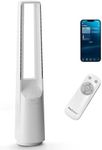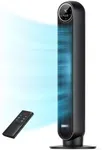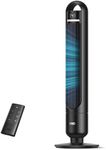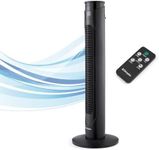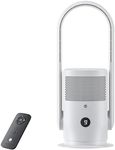Buying Guide for the Best Quiet Tower Fans
When choosing a quiet tower fan, it's important to consider several key specifications that will ensure you get a product that meets your cooling needs while maintaining a peaceful environment. Tower fans are popular for their sleek design and ability to circulate air efficiently in a room. The right fan for you will depend on factors such as the size of the room, your sensitivity to noise, and any additional features you might find useful. Understanding these specifications will help you make an informed decision and find a fan that provides the perfect balance of performance and quiet operation.Noise LevelNoise level is a crucial specification when selecting a quiet tower fan, as it determines how much sound the fan will produce while operating. Measured in decibels (dB), lower values indicate quieter performance. Typically, a noise level below 50 dB is considered quiet and suitable for bedrooms or offices where minimal disturbance is desired. If you are particularly sensitive to noise, look for fans with noise levels around 40 dB or lower. Consider your environment and how much noise you can tolerate when choosing the right noise level for your fan.
AirflowAirflow refers to the volume of air the fan can move and is usually measured in cubic feet per minute (CFM). This specification is important because it indicates the fan's ability to circulate air and cool a room effectively. Higher CFM values mean more powerful airflow, which is ideal for larger spaces or for those who prefer a stronger breeze. For smaller rooms or personal use, a lower CFM may suffice. Consider the size of the room and your cooling preferences when determining the appropriate airflow for your needs.
OscillationOscillation is the fan's ability to rotate from side to side, distributing air more evenly throughout the room. This feature is important for ensuring that the entire space receives adequate airflow, rather than just one area. Fans with a wider oscillation range can cover more area, which is beneficial for larger rooms. If you need to cool a specific spot or a smaller area, a fan with limited or no oscillation might be sufficient. Think about the layout of your room and how you want the air to be distributed when considering oscillation.
Speed SettingsSpeed settings allow you to adjust the fan's airflow intensity to suit your comfort level. Most tower fans come with multiple speed settings, typically ranging from low to high. This feature is important because it provides flexibility in controlling the fan's performance and noise level. If you prefer a gentle breeze, a fan with more speed options will allow you to fine-tune the airflow. Consider how much control you want over the fan's speed and how you plan to use it when selecting the right number of speed settings.
Timer FunctionA timer function allows you to set the fan to operate for a specific duration before automatically turning off. This feature is useful for conserving energy and ensuring the fan doesn't run unnecessarily, especially while you sleep or when you're away from home. Timers can range from 1 to 12 hours, providing flexibility in scheduling the fan's operation. If you want to manage your energy usage or have the fan turn off after you fall asleep, look for a model with a timer function that suits your routine.
Remote ControlA remote control provides the convenience of adjusting the fan's settings from a distance, without having to physically interact with the unit. This feature is particularly useful if you plan to place the fan in a hard-to-reach area or if you want to change settings while relaxing. Consider how often you might need to adjust the fan's settings and whether having a remote control would enhance your user experience. If convenience is a priority, look for a fan that includes a remote control.




